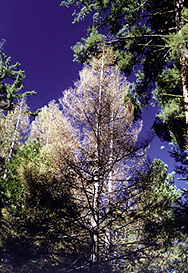|
Tussock Moth Infestation in Grant Grove
 The information on this page is put out in a brochure published by the National Park Service, the U.S. Forest Service, and the California Department of Forestry and Fire Protection. Tussock Moths are native to the Sierra, but they are rarely noticed until there is a population explosion. The tussock moth is an important defoliator of true firs and Douglas fir in Western North America from British Columbia to Arizona. It is native to the Southern Sierra in small numbers, however occasional outbreaks have occurred for unknown reasons. Historically, epidemics occur suddenly and, following a year or two of severe defoliation, subside abruptly. Some outbreaks in New Mexico, however, have persisted in the same general area for as long as 7 years. In the Southern Sierra, white fir appears to be the preferred host of the tussock moth as evidenced by the picture of the damage at left. Healthy trees of different types surround a white fir that has been killed by tussock moth caterpillars eating it. There were several areas in the park and in the surrounding national forest where you could see large areas of firs that had died off. The information on this page is put out in a brochure published by the National Park Service, the U.S. Forest Service, and the California Department of Forestry and Fire Protection. Tussock Moths are native to the Sierra, but they are rarely noticed until there is a population explosion. The tussock moth is an important defoliator of true firs and Douglas fir in Western North America from British Columbia to Arizona. It is native to the Southern Sierra in small numbers, however occasional outbreaks have occurred for unknown reasons. Historically, epidemics occur suddenly and, following a year or two of severe defoliation, subside abruptly. Some outbreaks in New Mexico, however, have persisted in the same general area for as long as 7 years. In the Southern Sierra, white fir appears to be the preferred host of the tussock moth as evidenced by the picture of the damage at left. Healthy trees of different types surround a white fir that has been killed by tussock moth caterpillars eating it. There were several areas in the park and in the surrounding national forest where you could see large areas of firs that had died off.
When full grown, caterpillars are about 1 1/4 inches long and have two long, black tufts (or "pencils") of hair behind the head. A similar, but longer pencil, is on the posterior end. The tussock moth gets its name from the four dense, buff-colored "tussocks" of hair along the middle of the back of the caterpillars. Shorter hairs cover the body and grow out of red dots. The body hairs of the tussock moth caterpillars irritate the skin of some people. There is also some risk of respiratory problems caused by inhaling an excessive number of airborne caterpillar hairs. I had one fall off a tree and down into the collar of my shirt. It caused a bunch of red, itchy welts to form on my neck from the secretions on the hairs of the caterpillar.
 Many natural agents keep tussock moth populations low most of the time. At low levels, over 90 percent of the caterpillars and 75 percent of the pupae and eggs are killed each year by natural factors. These include small wasps that parasitize the eggs and pupae, flies that parasitize the larval stage, and birds and other predators that eat large numbers of caterpillars, pupae, cocoons, and egg masses. Many natural agents keep tussock moth populations low most of the time. At low levels, over 90 percent of the caterpillars and 75 percent of the pupae and eggs are killed each year by natural factors. These include small wasps that parasitize the eggs and pupae, flies that parasitize the larval stage, and birds and other predators that eat large numbers of caterpillars, pupae, cocoons, and egg masses.
Periodically, tussock moth populations escape these natural mortality factors and reach large proportions. After a year or two, a natural nuclear polyhedrosis virus begins to increase rapidly. The virus, in combination with other mortality factors, frequently kills enough moths to cause the outbreak populations to collapse. Without viral disease, caterpillar populations are ultimately limited by the quantity and quality of available food.
Outbreaks such as this are one of the natural forces that have shaped the ecosystem. Therefore in wilderness areas or national parks, natural controls are left to do their work. Any trees that are killed by the outbreak contribute to a diversity of habitats that support varied wildlife.
Back to the Kings Canyon National Park - Grant Grove page.
Back to the National Park Page. |
 The information on this page is put out in a brochure published by the
The information on this page is put out in a brochure published by the  Many natural agents keep tussock moth populations low most of the time. At low levels, over 90 percent of the caterpillars and 75 percent of the pupae and eggs are killed each year by natural factors. These include small wasps that parasitize the eggs and pupae, flies that parasitize the larval stage, and birds and other predators that eat large numbers of caterpillars, pupae, cocoons, and egg masses.
Many natural agents keep tussock moth populations low most of the time. At low levels, over 90 percent of the caterpillars and 75 percent of the pupae and eggs are killed each year by natural factors. These include small wasps that parasitize the eggs and pupae, flies that parasitize the larval stage, and birds and other predators that eat large numbers of caterpillars, pupae, cocoons, and egg masses.